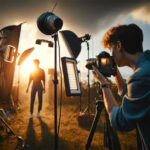It sure can get boring when you’re forced to stay indoors for quite a long time. However, it doesn’t mean that you should put your creative photography to rest. Instead, how about taking such time as an opportunity to try out something creative and fun with photography? Today we have photographer Gavin Hoey from Adorama sharing his insights on how to take photos of water drops at home:
As Hoey mostly shoots portraits in his home studio, he has the necessary equipment for taking portraits. However, he demonstrates how you can use the same set of gear along with some other household items to photograph water droplets. Here’s what you’ll need:
- A flash with softbox
- A macro lens or any lens with a short minimum focusing distance
- A tripod
- A light stand with a boom arm
- A bucket of water and a jug
- A plastic bag
- A screw or a nail shoved into a bit of Blu Tack
- A tray to drop the water into (ideally black)
With all of these things in place, fill the plastic bag with some water, place it up on the boom arm and make a small hole in it. But before you make that hole, be sure to place a tray filled with some water below the plastic bag to collect the water drops. The idea here is to photograph the water drop just as it creates a splash with the water in the tray.
To make your focusing easier, place the nail with the Blu Tack at the spot where the water is dropping the most. You can then focus on the nail once, and leave the lens to manual focus. This way, you don’t need to focus repeatedly.
As for your flash, aim to work with the lowest power possible to perfectly freeze the splash. Also, as Hoey demonstrates, be sure to cut-off any ambient light from affecting the image. Set your shutter speed to the flash sync speed, aperture to about f/11 or narrower for greater depth of field, and the ISO to about 400 depending on the flash power.
“The lower the flash power, the more it freezes the splashes.”
Once you’ve watched the video, definitely have a go at this yourself. You don’t need the exact same kit to achieve similar images. Make the best use of what you have lying around. This way you can create images that are similar but unique to you at the same time.
Like This Article?
Don't Miss The Next One!
Join over 100,000 photographers of all experience levels who receive our free photography tips and articles to stay current:





Leave a Reply